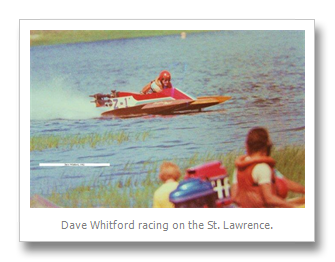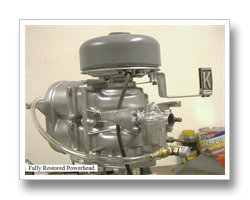In mid-September 2011, I visited the Thousand Islands briefly from my home in East Virginia to gather material for an article in Thousand Islands Life magazine about Hunter Grimes. The Fishers Landing Racing Club was running its annual regatta over on Crystal Lake near Redwood, so it was a good opportunity to meet and interview Hunter when he was at his best: racing boats as his Gulf Hall of Fame father had done years before.
I arrived two days early so that I could spend some time with my good friend, Doug Reed. I’ve known Doug since 1953 when he showed me how to operate the ten-horse Johnson that my dad had just rented from his father, Gerald E. Reed. Gerald operated Fisher’s Landing’s other marina, the boat enterprise tucked around the corner farther into Mullet Creek Bay from Harry Chalk’s impressive dock frontage.
Doug and I spent most of our visit in his spacious-but-cluttered garage workshop across from his house on the river front. We puttered with outboard engines and parts, happier than clams, just as we had done in the late 1950s and 1960s in his father’s marina workshop.
Doug’s house, incidentally, two doors upriver from Foxy’s restaurant, had been his grandfather’s house many years before Doug began refurbishing it as his permanent residence in about 1970. By then grandpa Howard was long gone. Howard Reed had operated the general store in Fishers Landing between his house and Foxy’s restaurant, but that was far before my time at the Islands, which began in summer 1953. Whether Howard was still alive then, I don’t know, but I never met him. My earliest recollection about the store was that Earl Buckley ran it, for quite a few years in fact, before returning to Rochester. What a character Earl was! But his wife, Jean, was a real sweetheart.
I did, however, meet Doug’s Grandpa Lee, who was one half of the Fitzgerald and Lee boat builders in Alexandria Bay before World War Two. What great stories he had! I’d returned to the Landing after taking my Air Force discharge in October 1964. Gerald had died the previous summer, and Doug and his mother, Janice, were struggling to keep the marina business going. I needed a job, and Doug needed help, mostly storing boats and engines at that time of year. Grandpa Lee would come across the road from Janice’s house and watch Doug and me at work in the morning. Then he would shuffle back to the house, shaking his head. At lunch in Janice’s dining room, Grandpa Lee would gently “review our work habits” with Doug and me.

Doug began racing outboard runabouts a scant few years after 1953 as a teenager. When he got me started in 1960, he was already a five-year veteran. He soon became one of North America’s best racing-runabout drivers. A natural athlete, he was like a cat in his boat, always kneeling in the exact correct spot for every condition around a racing oval.
My best story about Doug was one he told on himself: “David,” he said in his tenor voice, “I went into the first turn in about 3rd place, couldn’t see nothing of course, and my helmet went completely under water when I rolled my boat up into the turn. When my head came back up, I was in 1st! Then I just won.” Typical Doug Reed, forever my hero.
While I still can’t quite relate to Doug’s momentary underwater dilemma, he described the difference between his driving of runabouts and my driving of the more aero-borne Z-1 hydroplane. The difference for Doug was his ability to athletically roll his boat up on its left edge to drive it through a corner. Doing that in a hydroplane is impossible. When Doug “strapped on” his 28-N race boat, he was more than merely kneeling in it for the ride.
My own racing background is what partway motivates my current project. In 1985, Doug sold me the parts to assemble an A-Stock Mercury racing engine for use by my teenage daughter, to see whether she might want to follow her father into boat racing. I understand now how my idea to start a family dynasty of boat racers was selfish. I then knew several four-generation racing families. Doug himself represents the middle generation of a three-generation racing family. Gerald raced before World War Two, and Doug had a brother, sister, two sons, and two nephews who all raced. And my Kristi showed an interest.
I bought a big C-Stock hydroplane in which the little engine could never have gotten Kristi into trouble during practice. Then she had a heart attack and died suddenly just shy of sixteen, and I just left the motor parts in boxes. They remained in those boxes during two moves in the ensuing sixteen years.
Anyway, while Doug and I were tinkering in his workshop, he said “David, what did you ever do with all those engine parts I sent you?”
“Still in boxes,” I said. “When Kristi died, I ran out of steam for that project.”
“You might think about putting them together,” he said. “Collector market is growing.”
When I visited again in September 2012, I’d taken inventory of my parts and identified those that I lacked. I raided Doug’s old parts stash, leftover from when he was a Mercury dealer, went to the Crystal Lake regatta with him the following day, and returned home to Virginia to continue my restoration work on the engine.
Refurbishing the fuel tank proved to be the biggest challenge.
The tank on these old engines is their crowning glory, the identifier of their manufacturer’s marque, much like the body of a vintage automobile. While I’m an experienced old hand at repairing mechanical things in which function, not cosmetics, is paramount, I never before ventured into auto-body repair, a real art form unto itself. I especially did not want to mess up this tank rework with amateurish repainting.
All the fuel tanks for Mercury’s 7-1/2-horse (KG-4) and 10-horse engines during the 1950-’52 era were the same. They all held something less than two gallons and provided about an hour’s running time, after which you needed to lean precariously over the stern of your possibly wave-tossed boat and refill from a handheld spare can of fuel through a precariously perched funnel. Guess how many such funnels are now at the bottom!
The various postwar 1940s and early 1950s Mercury models had differing “identifier rings” around the base of their fuel tanks. The ring for the 1950-’52 KG-4 Rocket Hurricane is relatively rare. The rarest ring of all was the one on the Super 10 Cruiser, produced only in 1952, the final Mercury 10-horse engine (KH-7) in a series of four.
I swapped Doug the Cruiser ring that I had for a complete KG-4 tank and ring. I would’ve swapped him just the rings if we’d been easily able to get the KG-4 ring off its tank for my purpose. The KG-4 ring was stubborn about coming off because, as I learned while stripping off four layers of paint, it was fiber-glassed in place with “bondo” auto-body putty.
So I ended up with two tanks, the Cruiser tank with one dent and all the factory green paint, and the KG-4 tank assembly, an unknown quantity, painted black as I received it. These aluminum tanks were always subject to dents, either because of bumps while their boats were moored at docks and tossed by boat wakes or by bad handling during transport. It would’ve been nice to have been able to use the Cruiser tank, which would’ve taken far less work. I’ll restore it too, a shame not to because of all the auto-body material I accumulated for this project.

As my work with the KG-4 tank assembly progressed, it was clear that tank and ring would not budge from one another. None of the four layers of paint was the original Mercury factory green, which meant that at least one person had stripped the tank to bare metal before I did. I also uncovered numerous bondo-filled dents. I commented to Doug that enough paint and bondo were on this tank to sink a proper race boat. What’s important is that someone or numerous different people cared enough to keep this tank in racing during the 1950-1980-ish period when these little Mercury engines held sway until finally replaced by more modern Johnson and Evinrude engines.
The restored engine is now on display in my den on a wooden stand. While it might never run again, it will be able to, as though right from the factory floor. Now all I need to do is build a new boat for it.
By Dave Whitford
Dave Whitford was a professional technical writer for IBM. However he is quick to report his overall background is “an exiled River Rat; boat mechanic at Reed's, Mercers, & Central Florida; and as a general misfit”.
Dave now lives in East Virginia near Williamsburg. He is a contemporary of Dick Whithington and first wrote TI Life when he read about Dick’s experiences in Winter Islanders. His short story “Duck Hunting”, was published in TI Life in March 2010. In October, 2011 he wrote About Hunter Grimes, Inheritating a Cottage December 2011 and 50 Year Old Sailing Memories in January 2012. In September 2011, he wrote “Tinkering” giving a tribute to the late Riggs Smith and Smith’s outboard racing days. “Tinkering” and a version of this article have previously been published in the literary magazine - Righter Monthly Review.